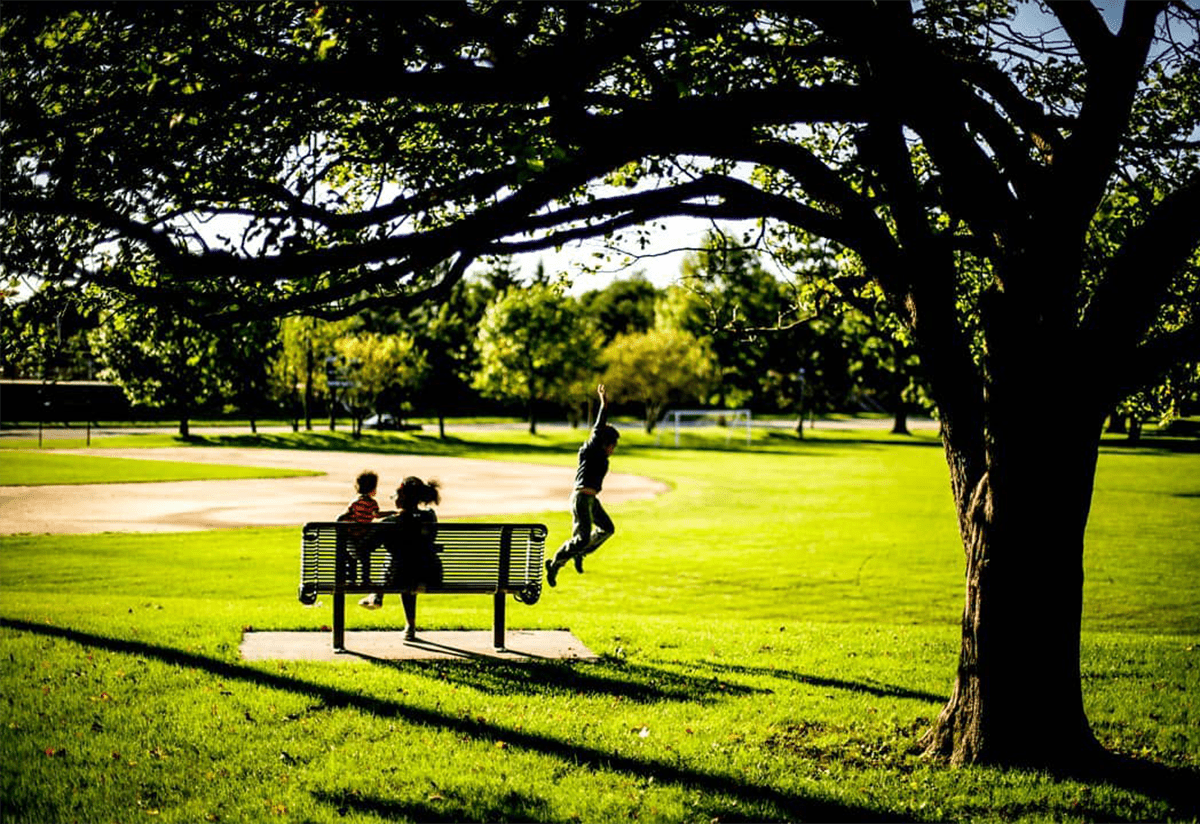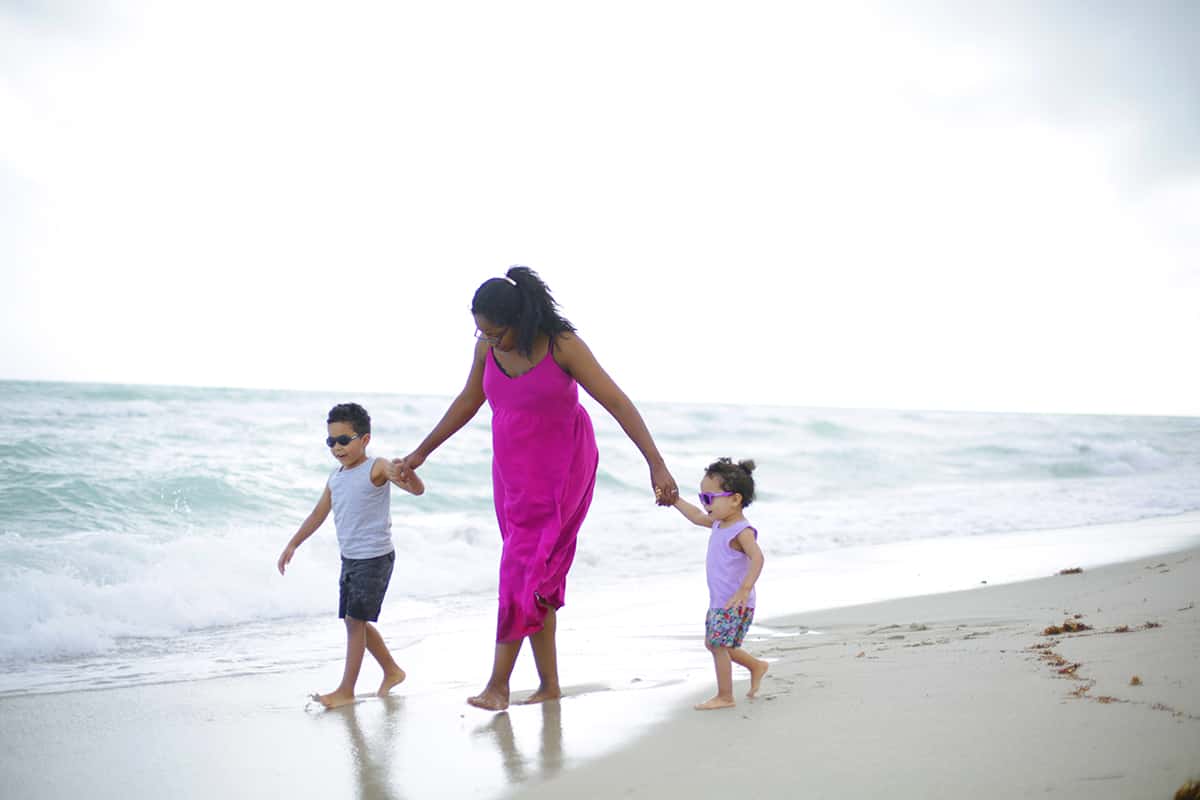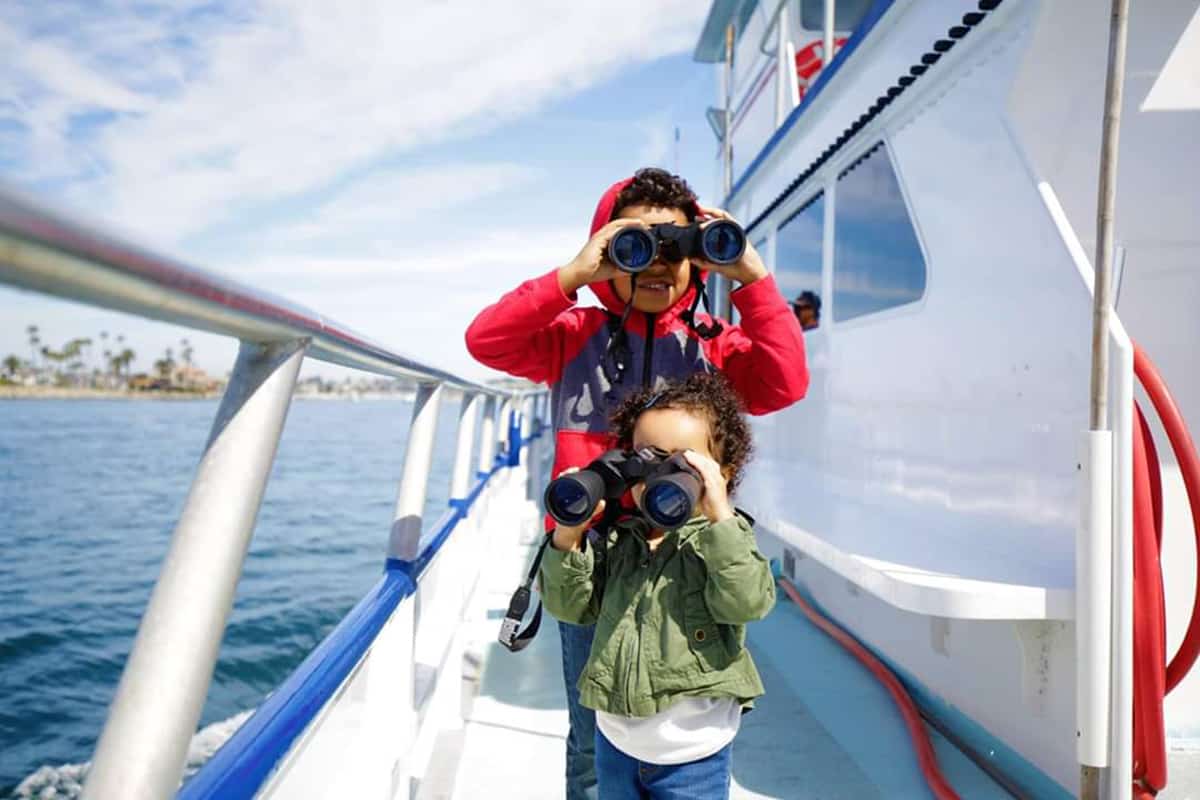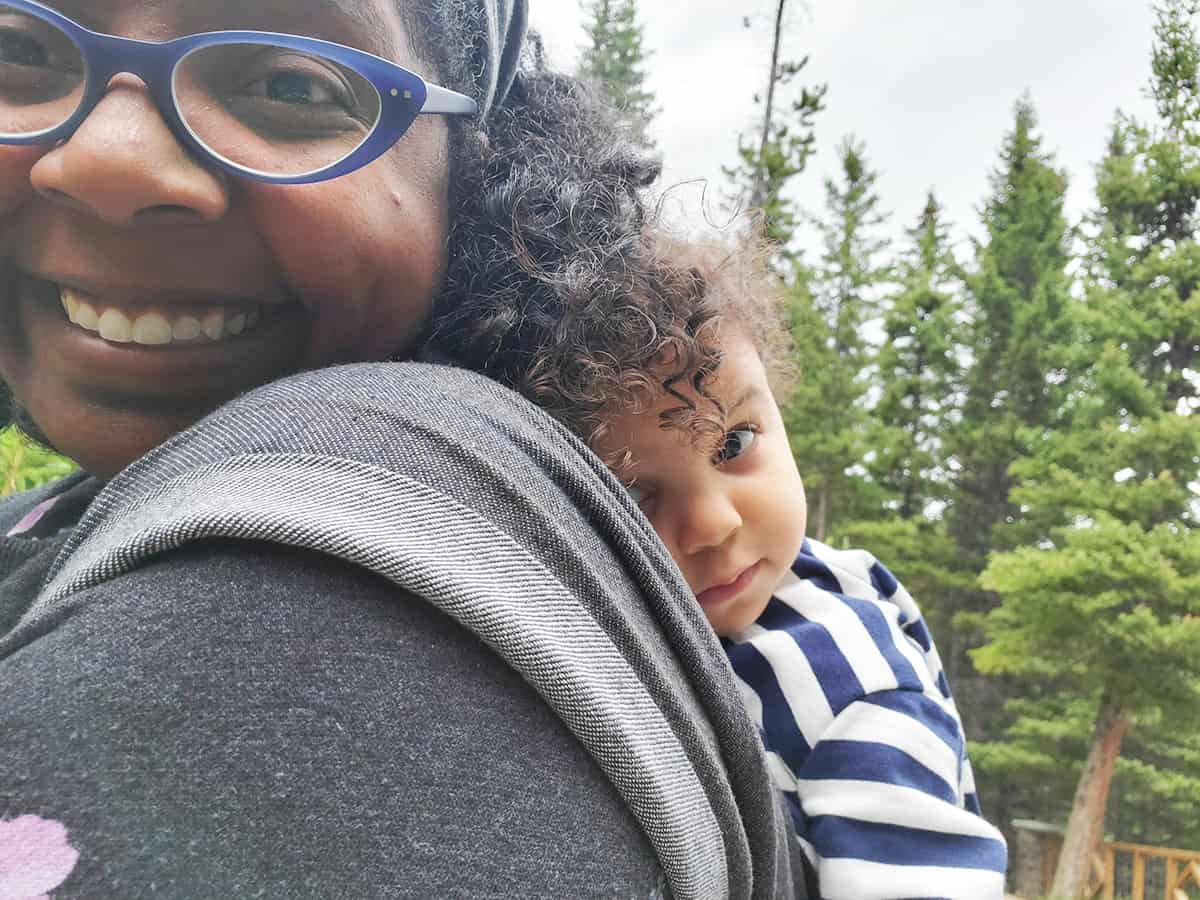Getting outside and enjoying nature doesn’t come easily to everyone. Some people are more comfortable inside. Others are intimidated by nature and think that to be “outdoorsy” you have to be climbing mountains and own expensive hiking boots. But, anyone can be outdoorsy – it just takes a mindset of enjoying and appreciating the outdoors. Today, Tiana Kubik, Creative Team member and Chicago mom of two, is here with some advice on how to embrace the outdoors when you’re not outdoorsy. She’s sharing some really fantastic tips for how to get yourself more comfortable and confident spending time outside with your kids. We hope this inspires you to try some new things and want to learn to embrace the outdoors.
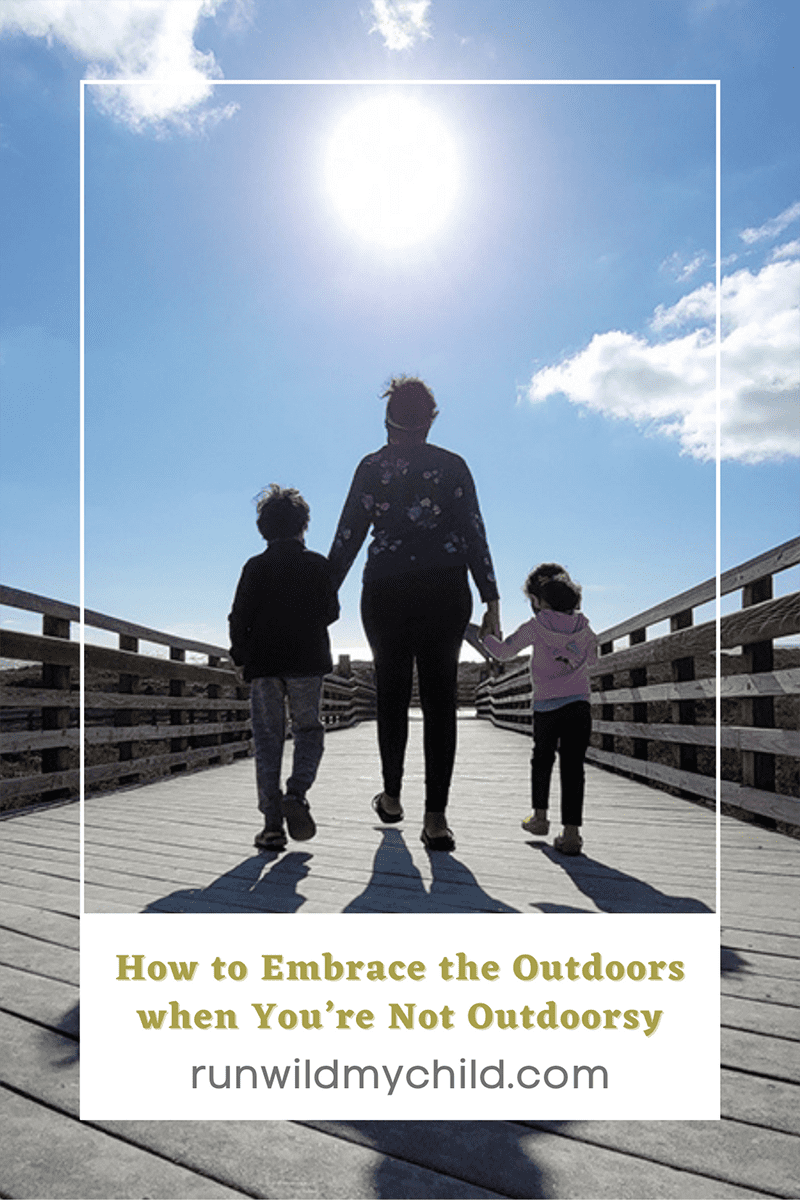
Not outdoorsy
Some parents introduce a love of nature to their kids because they were raised outside and love spending time outdoors immersed in all things nature. However, some of us went our whole lives avoiding the woods until we had children. Maybe we didn’t necessarily love (or hate) going outside, but it wasn’t a priority. Maybe we just always felt more comfortable indoors? For whatever reason, it was our children who introduced (or reintroduced) us to the beautiful connection we can have to the earth. We’ve grown to appreciate nature, but it doesn’t come naturally. Does this sound familiar?
What does it mean to be outdoorsy
There is no one all-encompassing definition of what it means to be outdoorsy. I think that being outdoorsy just means that you enjoy the outdoors, in whatever capacity you want that to include. Maybe it means that you enjoy sitting around a campfire, telling stories and roasting marshmallows. Maybe it means that you like taking walks in the park, listening to the birdsong, and feeling the breeze. Or maybe it means you love to camp, fish, hike, kayak, climb, ski, bike, or run outside. Being outdoorsy can mean whatever you want it to mean. It’s embracing nature and enjoying spending time outside.
Learning to embrace nature
The good news is that you don’t have to be typical “outdoorsy” to get outside with your kids and enjoy nature. You don’t have to be into mountain climbing or thru-hiking. You don’t have to like bugs or own a bunch of fancy gear. All you need is an appreciation for the beauty of nature and what nature can do for you and your kids.
The benefits of getting outside are undeniable. We can all agree that playing outside is great for children. We tend to downplay how important it is for adults as well. Spending time outdoors reduces anxiety, improves overall health, and helps anyone feel more connected to the world and community.
You can seek nature experiences for your kids, but you can also take it to the next level and seek nature experiences with your kids. This can happen even if you are not outdoorsy or a natural-born nature lover, even if you are itching just thinking of walking in the woods with bugs, even if the thought of hiking is exhausting. You can work to overcome those negative associations and embrace the wonder of the world with your kids. Here are some tips on how.
Find inspiration through education
Inspiration and education tend to go hand in hand. If you’re not outdoorsy, it may just be because you don’t know much about nature or the amazing things going on right outside your door! The more you know about nature, the more you can learn to appreciate and respect it. The beginning of overcoming any fear or limitation is wanting to overcome that restriction. So, if you think the outdoors are horrible, you have no motivation to push you out of your comfort zone.
On the flip side, if you are flooded with inspiration on how beautiful the world is and how much people enjoy it, your FOMO (fear of missing out), will motivate you to explore ways to obtain the experiences and views that others say are not to be missed.
After you are motivated to get outside, learning about nature and the earth will snowball your motivation and lead you to take concrete steps to engage in nature.
1. Documentaries
Documentaries are a great family activity for inspiring and educating. Often these documentaries can lead to philosophy shifts and encourage everyone to engage more with the earth. A documentary can motivate you to be eco-friendly and do simple things around your house to be more sustainable. A documentary can inspire you to travel, raise awareness about topics, and give you a glimpse into other cultures. The wonderful thing about documentaries is that you don’t have to wish you were in a location. You can set goals and plan to visit them.
Some of our favorite documentaries to inspire a love of nature and travel?
- DisneyNature Series — This is a stunning and heartwarming “Time in the life of…” series for a ton of different animals (penguins, elephants, butterflies, and so many more).
- Down to Earth with Zac Efron – This is a fantastic journey around the world with Zac Efron (yup, THAT Zac Efron). He takes you on trips to explore sustainable and innovative communities across the globe.
- National Geographic – Available on Disney+, NatGeo has an extensive library of documentaries on everything in nature, from animals to the ocean to space exploration!
2. Books
Books are another great source of information for learning to love and appreciate nature. The options are endless between kid-friendly storybooks and books focused on adults. Either way, reading about nature, animals, and topics such as sustainable living, will leave a lasting impression that will push you closer towards a goal of getting out there.
Want some recommendations for books about nature? Here are some of our curated book lists for nature books for kids:
- 40+ More Beautiful Nature Books for Kids
- 10 Diverse Nature Books for Kids
- Best Educational Nature Books for Kids
- Nature-Themed Holiday Books for Kids
- Nature Books for Little Naturalists
3. Make friends
“Just go make new friends!” I know easier said than done, but this truly is the best way to be inspired. Find friends with children of similar ages and interests as yours that love being outdoors. Not only will this inspire you to get out, but you will also have buddies to be your co-conspirators. If they already adore the outdoors AND they adore you, they will naturally want to be a resource for you. You can all explore and learn together and from each other about nature and be more willing to try new things.
You can find friends from your kids school or daycare, from local mom groups on social media, from apps, from visiting local parks or playgrounds, or attending outdoor events. Making new friends as an adult can be hard, but it’s worth it! Sometimes you just have to put yourself out there and give it a try.
4. Social media
Curating your social media feeds to include accounts that are living the life you are working towards is a great way to stay inspired and learn a lot about the real deal of that lifestyle. For getting outdoors, Instagram and Youtube have the most prominent communities and wealth of information for living, traveling, or just playing outside with kids. Not only will you be able to follow accounts to get an accurate snapshot of what life is like for them, but you will also have constantly NEW inspiration with minimal effort. Follow accounts that will introduce you to guides, tutorials, challenges, and resources to help you in your journey to embrace the outdoors.
There is no bad weather, only bad clothing.” Scandanavian saying
Prepare for the experiences you want
Being prepared will play the most significant part in becoming outdoorsy and having successful outdoor adventures with your kids. That means not only being prepared physically with the right gear and snacks, but being mentally prepared and having realistic expectations.
Going back to inspiration and education, you can find the best ways to prepare for any outdoor adventure. It is also essential to consider what you are concerned about and prepare yourself for that experience. For example, if the mosquitos love to feast on you, being prepared with repellent, anti-itch, Benedryl, etc., will make your experience much more enjoyable and less irritating.
Preparation extends beyond the “things” you will need. Making sure that you are physically and mentally ready is also vital. Here are some considerations for preparing for a successful outdoor experience with your kids.
1. Mental preparations for getting outside
Sometimes the first step to becoming more outdoorsy is a mental mindset shift. Overcoming mental blocks, changing negative associations to positive, and healing unhealthy associations will take some work and isnt’ always easy or quick. The amount of work and time depends on your experiences and how deep the associations go.
But, just because you may have had past experiences that made you dislike or uncomfortable in nature doesn’t mean you’re doomed to be a homebody the rest of your life. The following activities can help you promote a healthy and positive connection to the earth and help you get more comfortable being outdoors.
- Grounding – Grounding is the act of connecting your physical body with the earth. The act of grounding (also called earthing) is a therapeutic technique that involves doing activities that “ground” or electrically reconnect you to the earth. Meaning, when you physically touch the ground electrical charges are transferred from the earth – providing positive effects to your body. In simple terms – go outside, take your shoes off, and make direct contact!
- Yoga – Practicing yoga is about physical and mental grounding. Some benefits will help you physically, however, yoga teaches you to control your breathing and connect your mind to how your body moves. This can be enormously helpful when engaging in outdoor activities.
- Meditation – Much like yoga, learning to be more aware and present will prepare you to take in and love all that nature has to offer, especially when you reach the point in a hike where cell phones are no longer working.
- Sit spotting – Similar to meditation, sit spotting involves the natural world around you and it becomes incorporated into your mindful meditation. The idea of sit spotting is simple: find a special place in nature and then become comfortable with just being there, still and quiet. In this place, nature will surround you, soothe you, entertain you and seep into you. Sit spotting gives you a personal and intimate place in nature which will soothe, comfort and relax you, as you get to know the location.
- Therapy – Depending on your past experiences, level or fear/dislike, and negative associations with the great outdoors, therapy might be an excellent option for working through mental blocks and creating strategies to shift the narratives you hold about nature.
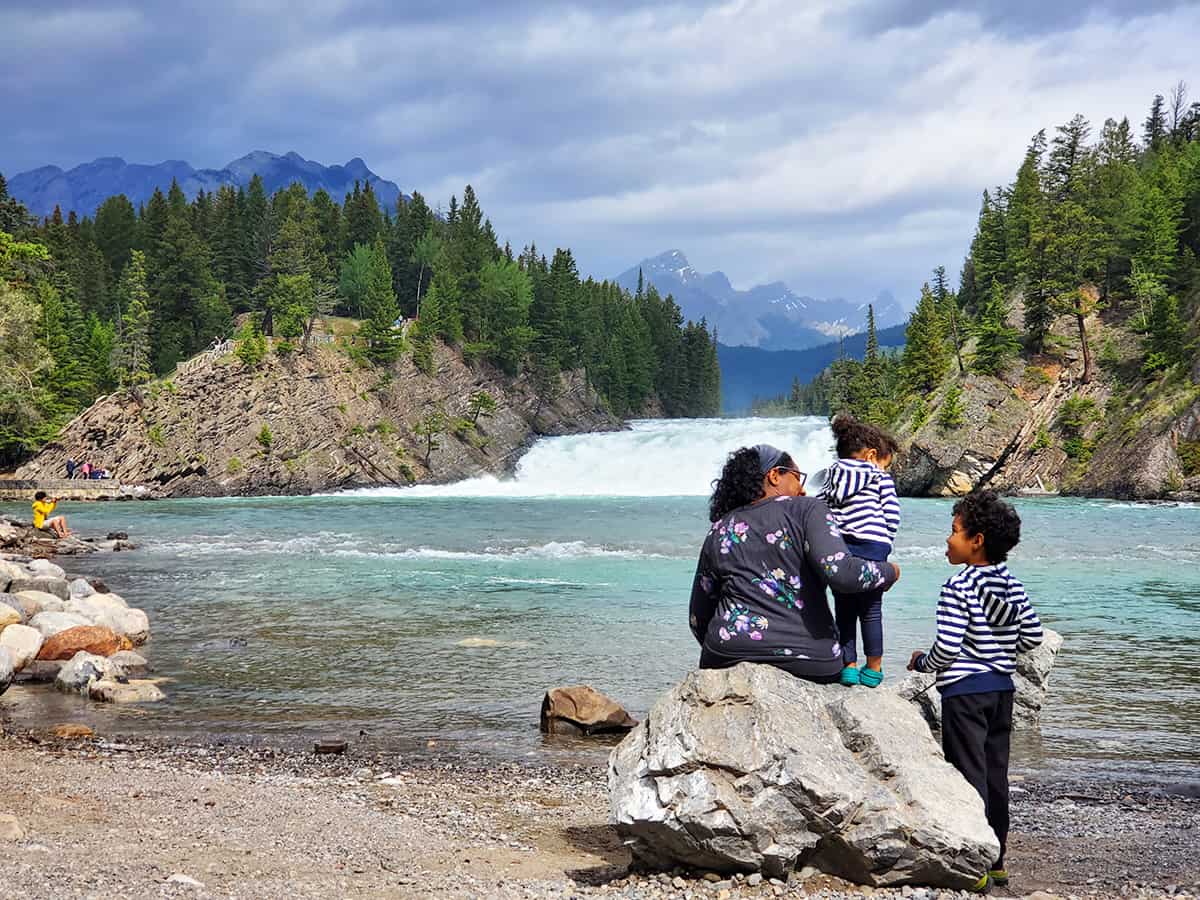
2. Physical preparations for getting outside
Physical ability to sustain outdoor activities is usually a huge deterrent for most adults. If you are physically uncomfortable or in pain, of course you’re not going to enjoy the activity. Eliminating any physical discomfort can help you reframe your mindset around spending time outdoors. For example, if you are preparing for a longer hike or adventurous and physical outdoor activities (like downhill skiing or climbing), you can train your body so that you can approach these activities relaxed and ready to enjoy the time in nature with your children. Here are few ways to help eliminate the physical discomfort around being outside:
- Start taking frequent walks. Choose to walk instead of driving. The the stairs instead of the elevator. Move your body more every day.
- Take on elevations. Start gradually adding some higher elevation hikes to what you’re already doing. Increase the elevantation and difficulty very slowly.
- Strength training can help you in a variety of ways. Not only will it make you feel more confident in your abilities, but will be beneficial when your toddler decides mid-hike that they no longer want to walk.
- Increase your water intake. This is an easy one that you can do well before you go outside. Hydrate ahead of time while you have easy access to bathrooms while your body adjusts.
3. Medical preparations for getting outside
Slightly different from physical preparation, medical preparation is necessary for anyone that has a medical issue that is keeping them from getting outside. This preparation is very specific to what medical needs you have. Be sure to talk to your doctor about your plans and concerns before making any changes to your medical regime. A doctor can help give you suggestions on how to manage the issue outdoors, prepare you for various scenarios and help you get more comfortable getting out of your comfort zone.
For example, if you are prone to allergic reactions or dehydration, your medical fears about what could happen might be keeping you from spending time outside. Talk to your doctor to see if there are options for you to find some relief or even underlying causes to treat.
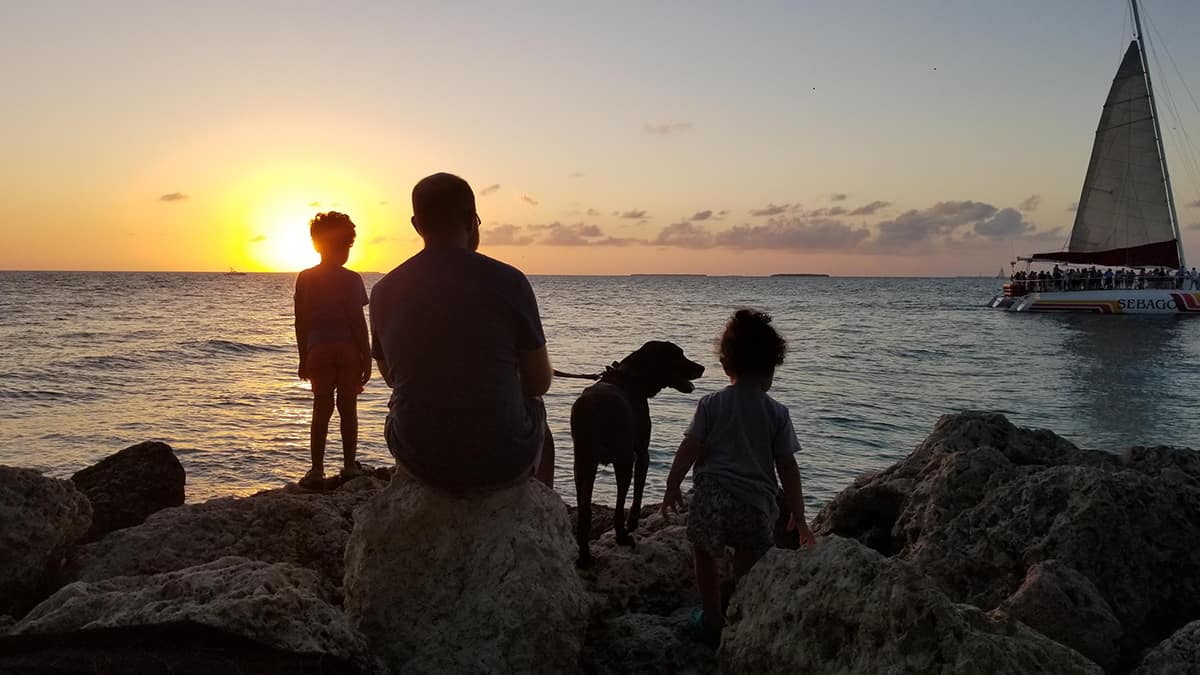
4. Having the right outdoor gear
Having the right gear can really help a “not outdoorsy” parent feel more comfortable and confident being outside. Where your budget allows, purchase high-quality durable items and find room for items on your wishlist. Having the right equipment, and the gear that makes you feel good will make the experience of the outdoors feel more like an extension of who you are.
While a lot of what you need will depend on where you are going, here are some quick gear items to think about adding to your outdoor gear stash for nature adventures with kids:
- Waterbottles
- Weather-appropriate clothing – for travel or hikes, layers will keep you prepared to change at a moment’s notice. This includes rashguards, hats and sunglasses for outdoor play in the summer, as well as wool layers, hats and gloves for wintertime play.
- A great camera or phone with a great camera
- For younger children, a compact baby carrier so that you can walk but be prepared to hold them and keep your arms free.
- A great backpack for ALL the water, diapers, and snacks!
5. Setting realistic expectations for outdoor activities
Setting realistic expectations about getting outside with your kids might be the hardest part of the adventure, but it will set you up for the best experience. Going into any activity that you previously found difficult and expecting to love it is not realistic. Shifting your mindset can be a gradual experience and it may take a bit of time. Start by taking notice of the things that you liked, enjoyed or appreciated during the activity. Focus on the good and try to hold on to those feelings and let everything else go.
The goal is to curate love and embrace nature as a beautiful part of your life. There is time to let that love grow, and if you are frustrated because you didn’t love it, you are less likely to try it again. It’s ok not to love it. But do try to appreciate the good and be willing to try again. The more you do something, the easier it will become and you may just find yourself enjoying the activity.
So, go into a new activity open-minded but know this relationship will grow over time and not need to be an instant connection.
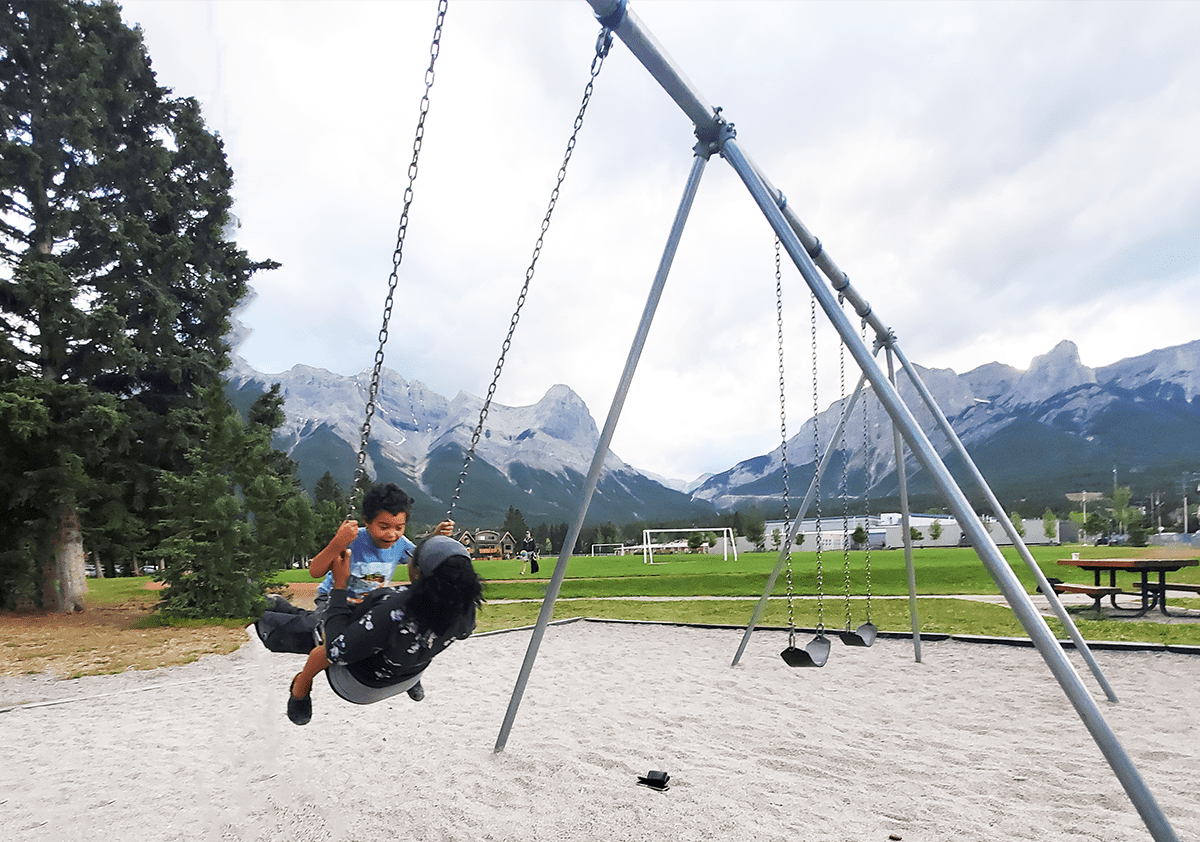
Now, go play outside!
Once you’ve addressed the ideas and issues discussed above, it’s time to get outside and learn to embrace nature and the outdoors. There’s so much out there waiting for you. So many adventures to be had and memories to make. Let’s get started embracing nature and becoming more outdoorsy.
1. Create a plan and stick to it
Start planning your experiences. Make a list of the things you’d like to do. Include realistic things that you can do now that are comfortable and easily accessible. But, also include a few things that are stretch goals that you’d like to be able to do someday. Those will keep you motivated to keep going.
For each outdoor adventure you take, get yourself comfortable with the outing before you ever leave the house. Map out where bathrooms are, think about any snacks and meals, consider what gear and clothing you’ll need. Then do it! Eventually, you will find things won’t take as much planning, but being over-prepared ensures that you won’t run into as many unexpected problems.
2. Start small and work your way up to bigger adventures
If you’re not outdoorsy, but want to spend more time in nature, taking baby steps will ease you in and create a snowball effect for embracing the great outdoors. It will also help you narrow down which experiences you really like and which ones are just not for you.
For example, before you go camping for a whole weekend, do an under-nighter outside. Sit by a fire, cook outdoors, sing songs and tell scary stories, all with the expectation that you are going home at the end of the night. (This can also be done in your backyard.) Once you are comfortable with that, try camping overnight somewhere familiar and close to home (so you can bail in the middle of the night, if you need to).
Same with hiking. Start with a walk in a flat nature preserve. Then seek out longer hikes with more inclines. Just like setting realistic expectations, you are building a foundation and nurturing your relationship with nature. Start small and build the trust over time. Jumping into something well beyond your comfort zone is dangerous and a sure-fire way to make you never want to try that activity again.
3. Say yes to adventure
As adults, we often find that saying no to non-preferred activities becomes a habit. Particularly, if you are not outdoorsy, saying no to a hike, canoe trip, or camping weekend will come out without even considering the experience. But sometimes there are opportunities to get outside all around you if you just start looking for them and saying “yes” when they come up. Friends are more likely to start asking you to do outdoor things if you make a habit of saying “yes!” to experiences you previously said no to. The more you agree to being outdoors, the easier those yesses will come and the more opportunities will arise.
4. Move your favorite activities outside
Do you love to read? Are you a fabulous cook? Do you enjoy working out? Is your home filled with plants? Do you paint or draw? Start with the things you love and enjoy and slowly shift them outside. Ttaking the things your family already does inside to the outdoors will add a whole new level of excitement and help you get more comfortable being outdoors. Piggybacking things you already enjoy to unknown experiences will give you a head start knowing you will enjoy it.
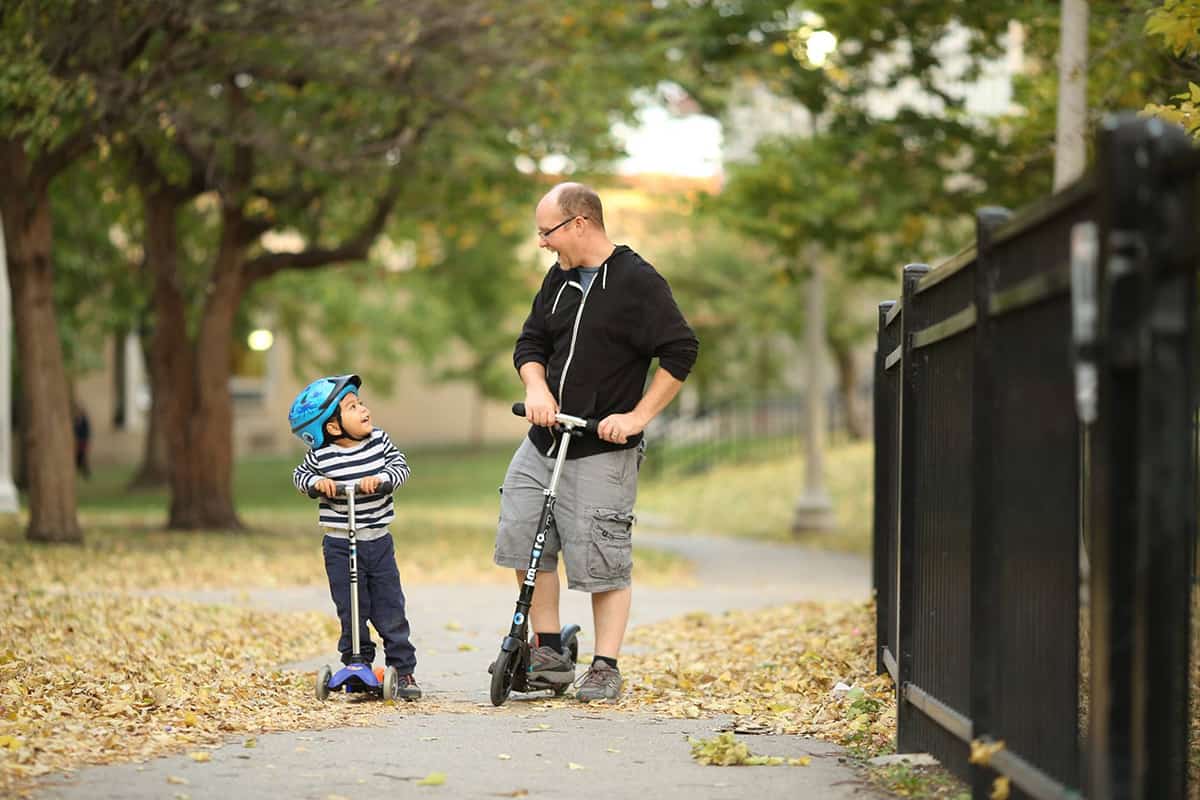 Creative ways to hold yourself accountable
Creative ways to hold yourself accountable
If you’re intimidated by the outdoors or need some additional motivation to get outside, one of the best things you can do is to find ways to hold yourself accountable to your outdoor goals. Sometimes this means enlisting help! Here are some ways that you can help hold yourself accountable to your goals of getting outside more often with your kids.
1. Tell your kids
Nobody on earth will hold you more accountable than your kids. They are watching you. They probably want to go outside! Make it a family goal to get you to love the outdoors as they do. Let them call you out when you aren’t meeting your goals. Let them show you how much they love the outdoors and how much fun they’re having. They will be empowered as human beings and will be your best cheering section when you show them how much you want to embrace changes.
2. Use a tracker
If you’re someone that loves seeing your progress or finds comfort in trackers and lists, consider using a fitness tracker, step tracker, or even just a calendar for goals you want to reach. Create a goal that you can reach and find tangible ways to measure your outside time. Having concrete goals will keep you accountable while you are forming a new habit. And make sure to celebrate when you hit that goal!
3. Do it with friends
There’s nothing like having a friend to get you through some of the initial hurdles and make it less scary. Find friends with similar goals and friends who are natural-born outdoorsy people. Set up playdates with mom friends outdoors and let the kids explore together. Picnics, hikes, and camping are all great activities to do as a group. Take turns checking out new parks, new trails or new activities. Or you could even start your own forest playgroup with some local like-minded friends!
4. Start a social media account or a blog
Small or large following, having a social media account is a fun way to keep people updated with what you are doing and hold yourself accountable. Post a photo and caption about all of your adventures and create an online community of people to cheer you on! Share your experience and what you learn. Not only will it help motivate you to continue trying new things and getting outside, but you may also inspire others to do the same!
5. Challenges and paid activities
Spending money is one of the most potent tools we have to help hold us accountable. There has been a lot of research on how paying for something gives us a sense of obligation. Sign yourself up for a paid challenge to get outside more. We have a great one that’s designed for parents of little kids with 7 themed days of fun (and easy) outdoor activities called The Wildhood Challenge. Paying for a curated experience will motivate you to follow through and help you be prepared for a great experience.
Enjoy the transformation to becoming outdoorsy
So, are you feeling “outdoorsy” yet? We hope these ideas and advice will help get you over any hurdles you might have to embrace the outdoors and get more confident and comfortable outside. Bookmark this post and refer back anytime you need some extra motivation or encouragement.
Now, take a deep breath and get ready for a new, nature-loving you. Find those adventures that feed your soul and bring your family closer together. The kids will love having you present in their world and you will love feeling on your way to becoming outdoorsy.
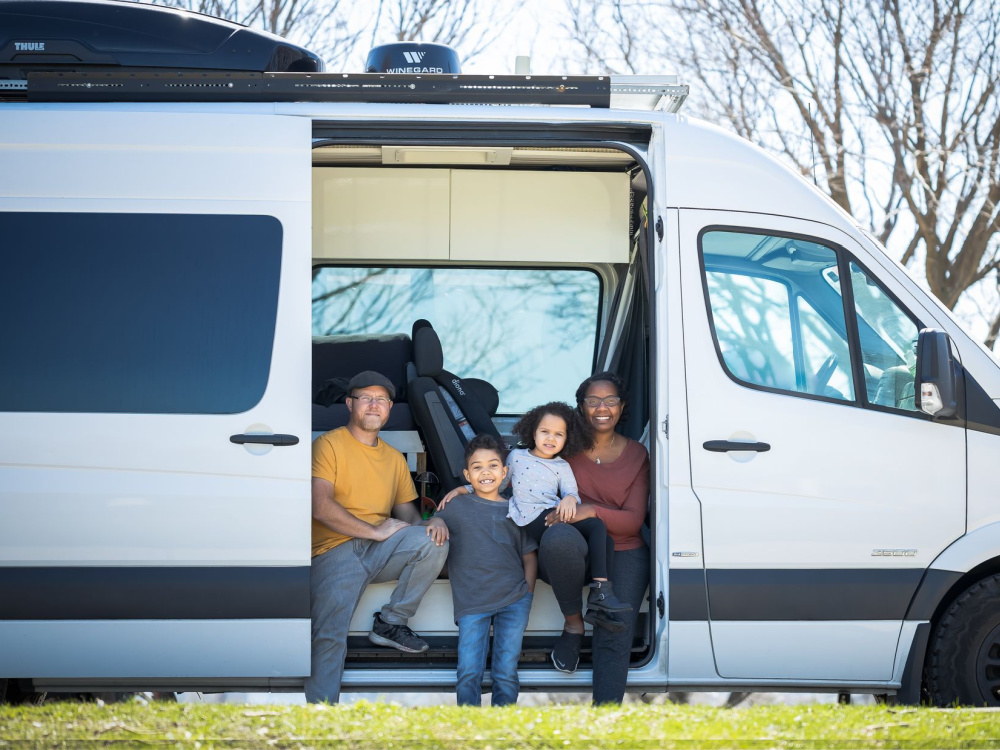
About the author
A city girl through and through, Tiana wasn’t always thrilled with outdoor adventures. However, learning the importance of nature + play through her journey to a Master’s in Early Childhood Education changed her heart. She still prefers the hustle and bustle of city life. She also has learned to love all that nature is and gives. Tiana has discovered unbelievably amazing North American destinations by traveling in a DIY converted Sprinter Van with her husband and two kids. She looks forward to new adventures and discoveries every day.
You can find more from Tiana in the following online locations:
Instagram: @usalongtheway
Website: US Along the Way
RWMC Posts: Tiana Kubik
The post How to Embrace the Outdoors when You’re Not Outdoorsy appeared first on RUN WILD MY CHILD.

